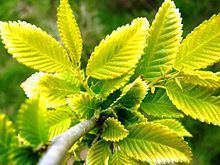Cultivar 'Aurescens' | Origin Germany | |
 | ||
Similar Ulmus davidiana var japon, Ulmus 'Purpurea', Ulmus minor 'Argenteo‑Variegata', Ulmus minor 'Purpurascens', Ulmus minor 'Goodyeri' | ||
The Ulmus pumila cultivar 'Aurescens' was introduced by Georg Dieck at the National Arboretum, Zöschen, Germany circa 1885. Dieck grew the tree from seed collected in the Ili valley, Turkestan (then a region of Russia, now part of Kazakhstan) by the lawyer and amateur naturalist Vladislav E. Niedzwiecki while in exile there. Dieck originally named the tree U. pinnato-ramosa f. aurescens.
Contents
Description
'Aurescens' is distinguished by its golden leaves on emergent shoots in spring; the foliage reverts to dark green by summer. The tree is otherwise identical to 'Pinnato-ramosa'.
Pests and diseases
This cultivar has not been scientifically tested for Dutch elm disease resistance, however several old specimens have survived unscathed by the disease in the UK. (see Notable trees).
Cultivation
The tree is rare in Europe and unknown in North America and Australasia. In trials in England, it quickly perished where grown on winter-waterlogged ground.
Notable trees
Two mature specimens are known in the UK: one at Bute Park Arboretum, Cardiff, planted c. 1980, height 15 m × 65 cm d.b.h. in 2004; another grows in a private garden at Seaford, East Sussex (see Accessions).
